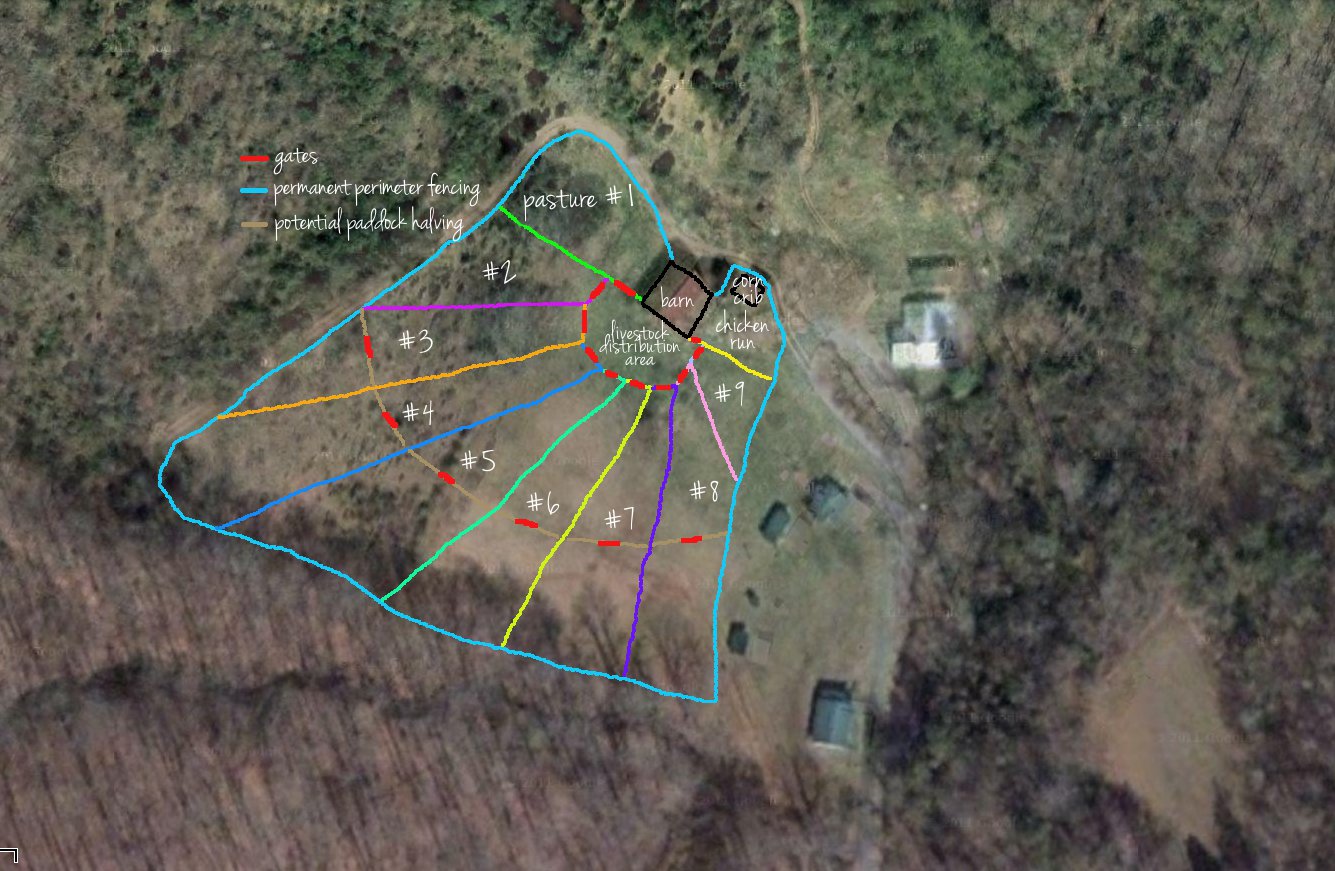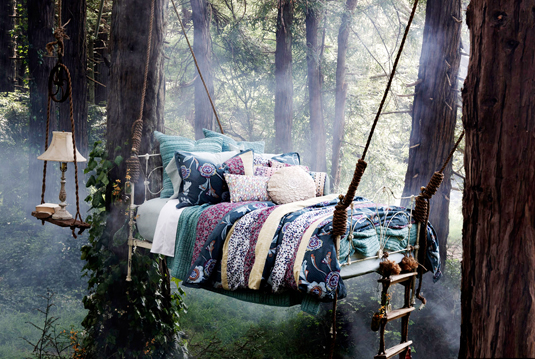Trying to determine what fences should go where when we're not totally sure how many animals we even want yet seems like a futile effort, so my thought process is to design a master plan that will allow us to build paddocks as we need them utilizing the placement of our turn-of-the-century barn that also permits design modifications if it just doesn't work well in real life like it does on paper.
 |
| Best to enlarge this so you can read my anal-retentiveness. Yea, I like pretty colors. |
We think that it might be wise to use the old corn crib as a chicken coop. The chickens would have their own run (for when we're lazy and don't want to herd them into a paddock), but this design would also let us turn them loose to graze (do chickens graze?) with the cattle and/or sheep. The cattle and sheep eat and poop, and the chickens follow behind eating bugs and spreading the cattle/sheep manure around as well as adding their own. I'm not totally clear on the details of mob grazing yet, and I'm not sure that we want to have as many animals as what is needed for that method, but I imagine this layout or some variation of it will allow us to still rotationally graze at least.
So once the livestock has grazed one paddock, however long that takes, we move them into the next paddock and let the previous one recover for however long is needed for it to grow back. This may mean that the paddocks need to be much smaller than what I have outlined (hence, the "potential paddock halving" lines on my illustration), but my math skills suck and I'm not going to even pretend that I want to calculate livestock consumption needs versus what we have available (my brain hurts already), so we'll only know that once we start actually grazing our livestock. Trial and error! We are open to the fact that we might need to actually go buy some hay, but we definitely like the idea of not having to buy supplemental feed, which I think justifies my ridiculous over analysis.
By the way, I'm going to call this the Mitsy's Bitchin' Sunburst Paddock Design because it reminds me of that cool stylized Japanese sunburst/sunrise art. Like this:
Using the handy Planimeter site courtesy of ACME as well as the Tennessee Property Viewer site, I estimate the amount of permanent perimeter fencing needed to fence in our grownup pasture area to be approximately 1,500 linear feet. Jay's brilliant idea is to follow the already carved out treeline that borders this area in order to save on fence posts and what not. We've already discovered this method used on our property with some old fencing that is no longer usable up on the ridge, so if it worked for whoever installed it way back in the day, we don't see why it wouldn't work again.
Temporary, movable cross fencing is less expensive than permanent fencing, but based on this design, I estimate the cross fencing will total at least 2,600 linear feet, including my "potential paddock halving" (about 2,200 without). My design also includes 16 gates. My gut tells me that we're gonna be building a lot of our own gates to save on costs. I have purposely focused on livestock breeds that are relatively easy to contain and happy to graze within their confines without much fuss. I've read that Highland cattle are so docile that they really only need single-strand electric fencing.
Which brings me to my next point: goats. Goats are escape artists. They can unlock gates and hop fences and shit. I'm a huge animal lover and proponent of ethical animal husbandry, but I want livestock to eat, not chase around our farm. I'd rather get my cute dose of the day from animals that I can reliably control. Like dogs and cats. So no goats. I say that now, lol
I learned yesterday that pigs really like, among other things, chestnuts. We have a big ass chestnut tree in the field where the old farmhouse used to be. As in, almost as big as the barn! So it would make sense to put some piggies there where they can fatten up on chestnuts and till the soil for me for future garden space.
Then if we need to move them somewhere else, I'd like to try fencing in some woods so that they can clear the underbrush and create a pretty forest setting so I can do something like this:
 |
| Wishful thinking, I know. |
This design also assumes that we will use the barn to house the animals instead of just throwing some make-shift animal shelters out there. I haven't yet figured out how rotational grazing might work with that method. Would we have to move the shelters into each new paddock or would the animals accept a new shelter every time we moved them?
So, yea, that's a lot of fence. Lotsa fence = $$$$. But my clever design will hopefully allow us to build our fences as we add more animals and as we can afford it. Even the permanent perimeter fencing could wait to be installed if money is tight.
I'd be so lost without aerial imagery.



One thing I learned from our chicken pastures last year (other than that chickens *do* graze if the grass is tender) is that long skinny paddocks like what you have can be problematic. Greg Judy recommends them during the soil building stage, but he's only putting his animals in each paddock for a day at most. If your animals are in there any longer, you'll start to get paths (that will later turn into eroded spots) running along the fences.
ReplyDeleteSome people will create lanes (which might even be graveled if your livestock are heavy on their feet) leading the animals back to a shelter. That way, you can have lots of small, square paddocks but not have to include a shelter and watering location in each one.
The artist in me wants to create something aesthetically pleasing, but that does not usually translate into efficiency. Square paddocks make sense. Back to the drawing board!
ReplyDeleteUsing trees as fence posts is a good idea. I'm surprised I haven't seen anything like that before! You could always start with docile animals and skinny paddocks, then work your way from there. Here's a crazy idea -- if you or your husband have a chainsaw and any woodworking skills, you can build temporary paddocks using fallen branches and trees from the woods nearby. It might save you guys a lot of money.
DeleteThat is an interesting idea, especially because I want docile animals, although I'm willing to invest in good quality fencing if it means less headache down the road. :)
DeleteI found your blog while googling rotational grazing designs. I LOVE your blog!
ReplyDeleteThank you! :)
DeleteHave you given any thought to "living fence"? I found an article on growing an osage orange fence... It takes abt three years but the end result is "horse high, bull strong, and hog tight" as my dad likes to say. We are considering using it along the creeks to keep the cows out of them. Its high tensile in the mean time, tho. Its a pretty interesting article. I will try to find the link again if you are interested.
ReplyDeleteI am interested in living fences - I just don't know if I have the patience to grow one! I've read that osage orange can be very invasive, but if done right, it might work well. I've also looked at fast-growing hollies and evergreen trees as options.
Delete